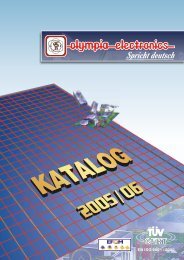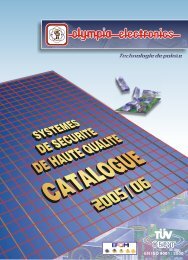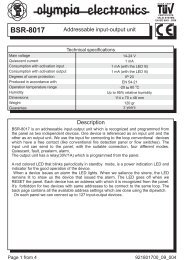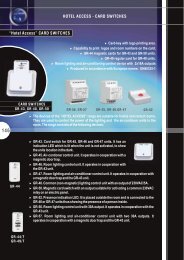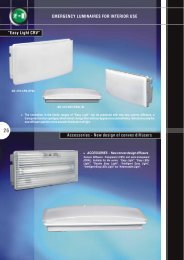BS-393 TS-293EA - Olympia-electronics
BS-393 TS-293EA - Olympia-electronics
BS-393 TS-293EA - Olympia-electronics
Create successful ePaper yourself
Turn your PDF publications into a flip-book with our unique Google optimized e-Paper software.
IST-2293.EA01.01 Istruzione / User’s Manual / Manuel d’utilisation Pag.1/6<br />
(I-ATEX_<strong>TS</strong><strong>293EA</strong>.doc)<br />
Trasmettitore 4÷20mA per Ammoniaca<br />
<strong>TS</strong><strong>293EA</strong><br />
4÷20mA transmitter for Ammonia<br />
Trasmetteur 4÷20mA pour Ammoniac<br />
Caratterizzati dal modo di protezione<br />
Have the following protection rate<br />
Sont caractérisés par le mode de protection suivant<br />
II 2G EEx d IIC T6<br />
Numero di Certificazione<br />
Certificate number<br />
Numéro du certificat<br />
CESI 03 ATEX 323<br />
Caratteristiche tecniche / Technical specifications / Caractéristiques techniques<br />
Alimentazione / Power supply / Alimentation 12÷24Vdc (-10/+15%)<br />
Uscita / Output / Sortie 4÷20mA Lineare / Linear / Linéaire<br />
Campo di misura / Standard range / Champ de mesure 0 ÷ 300ppm<br />
Massimo sovraccarico / Max overload / maximum surcharge 1000ppm<br />
Ripetibilità / Repeatability / Répétitivité ± 10 %<br />
Tempo di risposta T50 / Response time T50 / Temps de résponse < 30 secondi / seconds / secondes<br />
T50<br />
Deriva a lungo termine in aria pulita<br />
IST-2293.EA01.01 Istruzione / User’s Manual / Manuel d’utilisation Pag.3/6<br />
VERIFICA E/O CALIBRAZIONE<br />
Si consiglia d'eseguire la verifica di funzionamento e/o la taratura ogni 6/12 mesi. Il gas da utilizzare deve essere<br />
una miscela compresa tra 200 e 300 ppm di NH 3 e il resto da Azoto.<br />
Avvertenze: La verifica e/o calibrazione devono essere effettuate solo in condizioni d'aria pulita e dopo che il trasmettitore<br />
è rimasto alimentato continuamente per almeno 8 ore. Inoltre devono essere eseguite solo da personale<br />
addestrato e autorizzato. La regolazione dei trimmer va effettuata con un cacciavite d’adeguata dimensione.<br />
“Regolazione dello “ZERO” Aprire il coperchio della custodia. Collegare un multimetro digitale (scala 20 mA) in<br />
serie all'alimentazione. (Importante: scollegando il filo, vengono attivati i relè di allarme e di guasto della centrale a<br />
cui il trasmettitore è collegato).<br />
Attendere circa 5 minuti per permettere al Trasmettitore di stabilizzarsi, quindi verificare che in aria pulita il valore<br />
letto sia 4 mA (±0,5). Nel caso non si riscontrasse tale valore, solo se necessario, regolare il trimmer P1 "ZERO" a<br />
4 mA.<br />
Attenzione: verificare che nell'ambiente non ci siano gas tossici. In caso di dubbio, si consiglia d’utilizzare una<br />
bombola di aria sintetica o aria/ossigeno 20,9%O2. Collegare il Tester di Calibrazione alla bombola (Fig.4) ed infilarlo<br />
sul sensore. Aprire il rubinetto della bombola in modo che l'indicatore di flusso sia tra le due tacche (0,2÷0,3<br />
l/min), attendere circa 5 minuti, quindi verificare che i multimetro indichi 4 mA (±0,2mA). Nel caso non si riscontrasse<br />
tale valore regolare lentamente, il trimmer P1 "ZERO" a 4 mA.<br />
“Regolazione del Fondo Scala” Collegare il Tester di Calibrazione alla bombola di NH3 ed infilarlo sul sensore<br />
(Fig.4). Aprire il rubinetto della bombola in modo che l'indicatore di flusso sia tra le<br />
due tacche (0,2÷0,3 l/min), attendere circa 3÷5 minuti, poi verificare che il multimetro<br />
indichi :<br />
Esempio: se il gas della bombola è 245 ppm e il campo di misura del Trasmettitore<br />
è 300ppm, i mA corrispondenti sono 17,06 mA come indicato:<br />
Regolare molto lentamente e solo se necessario, il trimmer P2 "SPAN" al valore in mA richiesto, togliere il Tester di<br />
Calibrazione, attendere 5÷10 minuti e verificare che il multimetro indichi 4 mA. Scollegare il multimetro e richiudere<br />
il coperchio della custodia.<br />
GB DESCRIPTION<br />
The <strong>TS</strong><strong>293EA</strong> consists of a two-wire 4÷20mA linear transmitter able to detect Ammonia (NH3).<br />
The Ammonia (NH3) is a colourless gas with a very sharp smell. A concentration of 50÷100 ppm causes irritation<br />
of the respiratory system; beyond a concentration of 100ppm it causes eyes irritation. At 5,000 ppm the Ammonia<br />
is lethal.<br />
Its density as to air is 0.6, therefore it is lighter than air and it normally spreads upwards in the environment. Its LEL<br />
(Lower Explosivity Limit) is 15% v/v. The TWA is 25 ppm and the STEL is 35 ppm an “electrochemical” sensor calibrated<br />
in ppm NH3.<br />
The instrument comprises of a certified enclosure in which the electronic circuit and the connecting terminals are<br />
mounted. This unit has a downward facing cylindrical section housing the sensor behind a sintered stainless steel<br />
flame trap. The <strong>TS</strong><strong>293EA</strong> is designed to be connected to TECNOCONTROL gas detecting central systems.<br />
OPERATIONAL DESCRIPTION<br />
The sensitive element used is an “electrochemical” sensor. The calibration is carried out with Ammonia.<br />
When powered, the sensor the sensor is able to detect gas even if it attains the optimum stability conditions after<br />
about 48 hours continual functioning. After that time we advise to check in clean air the “4mA” output. If necessary<br />
the “4mA calibration” can be carried out as explained on page 6. This calibration is necessary to adjust the sensor<br />
to the environment conditions.<br />
Faults: In case of failure, the "S" output falls down to 0mA (FAULT). The signal is then indicated as a damage<br />
situation. The same happens also when an interruption to the connection wires between the sensor and the detector<br />
occurs.<br />
Average life: The sensitive element used in this type of sensor has an excellent stability in time. In fresh air and in<br />
normal working condition the sensor's life should be about 18 month from the date of the installation.<br />
Periodical testing: we advise to carry out working tests every six months. After 1 year, we advise to proceed to<br />
the circuit recalibration with Gas/Air mixture, as explained on page 4.<br />
INSTALLATION<br />
The <strong>TS</strong><strong>293EA</strong> is designed for standard two-wire operation where the output is supplied via the same wire pair as<br />
the power supply.<br />
The max load resistance (RLMax) will be the sum of the central system input impedances (RL) and the connection<br />
wire total resistance (going and return) (see Fig. 1).<br />
TECNOCONTROL S.r.l. Via Miglioli 47 SEGRATE ( MI ) Tel: 02/26 92 28 90 Fax: 02/21 33 734<br />
mA=<br />
16 x (concentrazione gas)<br />
campo di misura<br />
mA= 16x245<br />
300<br />
+ 4<br />
+ 4 =<br />
1 7 ,0 6
IST-2293.EA01.01 Istruzione / User’s Manual / Manuel d’utilisation Pag.4/6<br />
To calculate the RLmax refer both to the diagram of Fig. 3 and to the following<br />
formula:<br />
As an example, the RLMax of a 24 Vdc Power Supply will be what follows:<br />
To this purpose, it is recommended to use a shielded wire.<br />
The Table below shows the average resistance of some wires depending on their section:<br />
Section Resistance<br />
2 x 0,75mm 2 26Ohm/Km<br />
2 X 1 mm 2 20 Ohm/Km<br />
2x1,5mm 2 14 Ohm/Km<br />
2x2,5mm 2 8 Ohm/Km<br />
Positioning: The <strong>TS</strong><strong>293EA</strong> must be installed in the vertical position with the sensor housing placed downward.<br />
Normally the transmitter should be installed at about 30÷50cm from the ceiling to protect people from the Ammonia<br />
toxicity. Wall-mount the unit by two screw anchors.<br />
Electric connections: are to be carried out using the three-pole terminal (See special instructions enclosed with<br />
the gas detectors). It is not necessary to use shielded cables.<br />
Transmitters can be mounted at a max. distance of 300 meters from the gas detector when 3x1.5mm 2 cables are<br />
used, and 600 meters with 3x2.5 mm 2 cables. (With 12Vdc gas detectors power supply output).<br />
WARNING<br />
Warning: When the transmitter is powered for the first time of after a long time inactivity, the sensor needs about<br />
10-30 seconds to be reset to the normal operational conditions.<br />
Cross-sensitivity: A cross-sensitivity phenomenon with other gases may occur (see Table 1).<br />
IMPORTANT WARNING: in case of alarm situation, owing to an Ammonia leakage, it have to be<br />
always checked the sensor working, as indicated in this page. If the Ammonia concentration is<br />
higher than full scale (300ppm), it could be necessary to replace the sensor.<br />
Calibration and/or Verification<br />
We advise to carry out working testing and/or calibration, every 6/12 months. The gas to use should be a mixture<br />
of 200 to 300 ppm Ammonia and the rest of Nitrogen.<br />
Warnings: The calibration routine is to be carried out only in clean air and after about 8 hour’ instrument continual<br />
working. Any calibration routines are to be carried out by trained or authorised personnel only. For the trimmer adjustment,<br />
a suitable-sized screwdriver should be used.<br />
“Zero Calibration”: Open the housing cover, and then connect a digital multimeter (20mA scale) in-series to the<br />
Power Supply. (Important: by disconnecting the loop, the Alarm and Fault relays of the central system the transmitter<br />
is connected to will activate).<br />
Wait for about five minutes to allow the transmitter to get a steady condition. When in fresh air, the value to read<br />
should be 4mA (±0.5). If the readout is not 4mA, only if necessary, adjust the P1 “ZERO” trimmer to get 4mA.<br />
Warning: Be sure that there are not toxic gases in the environment. In case of doubt, you should execute either<br />
the 4mA verification using an air/20.9% O2 gas bottle or a synthetic/air gas bottle with the Calibration Tester. Connect<br />
the Calibration Tester to the gas bottle (see Fig.4) and insert it on the sensor. Open the gas bottle reducer<br />
cock so as the flow meter is between the two stamps (about 0.2-0.3 l/m). Wait for about 5 minutes, and then check<br />
the value on the multimeter is 4 mA (± 0.2 mA).<br />
“Full scale calibration”: Connect the Calibration Tester to the NH3 gas bottle and insert it on the Sensor (see<br />
Fig.4). Open the gas bottle reducers cock so as the flow indicator is between the two stamps (0.2÷0.3 l/m). Wait for<br />
about 3 to 5 minutes. Then check the value on the multimeter corresponds to 16 x (gas concentration)<br />
the value calculated following the formula here below:<br />
mA =<br />
+ 4<br />
trnsmitter range<br />
Example: if the gas bottle is 245ppm and the transmitter range is 300ppm,<br />
the corresponding mA value will be as follows:<br />
(Power Supply Voltage -10) x 1000<br />
RLmax =<br />
20<br />
(24 -10) x 1000<br />
RLmax = =<br />
700 Ohm<br />
20<br />
16x245<br />
mA =<br />
+ 4 =<br />
300<br />
If necessary, adjust the P2 “SPAN” trimmer to the required mA value. Remove the Calibration Tester. Wait again<br />
for about 5 to 10 minutes, and then check the digital multimeter shows 4 mA. Disconnect the digital multimeter,<br />
connect the wire and place again the instrument box cover<br />
TECNOCONTROL S.r.l. Via Miglioli 47 SEGRATE ( MI ) Tel: 02/26 92 28 90 Fax: 02/21 33 734<br />
17,06
IST-2293.EA01.01 Istruzione / User’s Manual / Manuel d’utilisation Pag.6/6<br />
“Réglage du “Zéro”. Ouvrir le couvercle du boîtier. Raccorder un multimètre (échelle 20 mA) en série à<br />
l’alimentation. (Important: la decon-nexion du fil entraîne l’activation des relais d’alarme et de dérangement de la<br />
centrale à laquelle la sonde est reliée).<br />
Attendre environ 5 minutes pour permettre au capteur de se stabiliser et vérifier qu’en pair pur la valeur lue est 4<br />
mA (±0,5). Si la valeur obtenue est différente, régler le potentiomètre P1 “ZÉRO” à 4 mA.<br />
Attention: Vérifier que dans l’ambiance il n’y a pas la présence de gaz toxiques. S’il y a des doutes l’on conseille<br />
d’effectuer la vérification du 4mA avec le kit d’étalonnage raccordé à une bouteille d’air synthétique ou air /oxygène<br />
20,9% O2 (Fig.4). Raccorder le kit d’étalonnage à la bouteille et au capteur. Le gaz afflue au capteur avec débit de<br />
0,2÷0,3 l/min, attendre eviron 5 minutes et vérifier que la valeur lue sur le multimètre est 4mA (± 0,2 mA).<br />
Réglage du Fond d’échelle: Raccorder le kit d’étalonnage à la bouteille de NH3<br />
et au capteur. Le gaz afflue au capteur avec débit de 0,2÷0,3 l/min, attendre environ<br />
3-5 minutes et vérifier que la valeur lue sur le multimètre est la valeur calculée<br />
avec la formule suivante:<br />
Exemple: Si le gaz de la bouteille est de 245 ppm et le champ de mesure du<br />
transmetteur est de 300 ppm, les mA correspondant sont 17,06 comme indiqué<br />
dans la formule:<br />
Régler le potentiomètre P2 “SPAN” à la valeur en mA demandée, seulement si nécessaire. Enlever le kit<br />
d’étalonnage, attendre 5÷10 minutes et vérifier que le multimètre numérique indique 4 mA. Enlever le multimètre<br />
numérique et fermer le couvercle du boîtier.<br />
- +<br />
<strong>TS</strong>220<br />
Cavo schermato<br />
Screened Cable<br />
Câble à écran<br />
V+ 0V<br />
Alimentatore<br />
Power supply / Alimentation<br />
S-<br />
TECNOCONTROL S.r.l. Via Miglioli 47 SEGRATE ( MI ) Tel: 02/26 92 28 90 Fax: 02/21 33 734<br />
RL<br />
Indicatore<br />
Receiver<br />
Fig. 1 Esempio di collegamento<br />
An example of a wiring connection / Exemple de raccordement<br />
RL(Ohm) = Resistenza di carico<br />
900<br />
Load resistor / Résistance de charge<br />
800<br />
700<br />
600<br />
500<br />
400<br />
300<br />
200<br />
100<br />
Area di funzionamento<br />
Allowable oparating region<br />
0<br />
10 20 24 28 Volts<br />
Alimentazione / Power Supply / Alimentation<br />
S+<br />
Fig.3<br />
0,3 L/min<br />
Fig.2 TC011 -Tester di calibrazione<br />
Calibration Tester<br />
Tester d’étalonnage<br />
Tab 1 - Interferenza ad altri gas / Cross-sensitivity Data with other gases / Interférence avec autres gaz<br />
Gas / Gaz Concentrazione<br />
Concentration<br />
Valore rilevato dal sensore<br />
Sensor value detected<br />
Valeur relevée par le capteur<br />
C2H5OH Alcool etilico / Ethanol 1000 ppm ≈ 1ppm<br />
CH3OH Alcool metilico / Methanol 1200 ppm ≈ 3ppm<br />
Cl Cloro / Chlorine 5 ppm 0ppm<br />
H2 Idrogeno / Hydrogen 1000 ppm ≈ 25ppm<br />
CO Monossido di carbonio/ Carbon monoxyde 300 ppm ≈ 3ppm<br />
mA=<br />
16 x (concentration gaz)<br />
champ de mesure<br />
mA= 16x245<br />
300<br />
+ 4= 17,06<br />
+ 4



